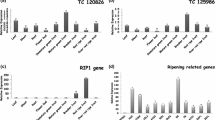Abstract
The 5′ region of the fruit-specific tomato gene, 2A11, contains both positive and negative regulatory elements. We divided the 5′ promoter region of the 2A11 gene into small fragments, ranging in size from 211 to 634 bp and used these short DNA fragments in in vitro protein-binding studies. These studies revealed the presence of at least four fruit-specific and one leaf- and fruit-active protein-binding domains. These promoter fragments, as well as other overlapping fragments, were tested for their ability to enhance expression from a truncated heterologous promoter in transgenic plants. This analysis showed the presence of four fruit-specific and three general or leaf-active positive regulatory elements. Comparison of the results obtained with these two approaches allowed us to draw a functional map of the 2A11 promoter.
Similar content being viewed by others
References
Benfey PN, Ren R, Chua NH: The CaMV 35S enhancer contains at least two domains which can confer different developmental and tissue-specific expression patterns. EMBO J 8: 2195–2202 (1989).
Benfey PN, Ren L, Chua NH: Combinational and synergistic properties of CaMV 35S enhancer subdomains. EMBO J 9: 1685–1696 (1990).
Bird CR, Smith CJS, Ray JA, Moureau P, Bevan MW, Bird AS, Hughes S, Morris PC, Grierson D, Schuch W: The tomato polygalacturonase gene and ripening-specific expression in transgenic plants. Plant Mol Biol 11: 651–662 (1988).
Bourouis M, Richards G: Remote regulatory sequences of the Drosophila glue gene sgs3 as revealed by P-element transformation. Cell 40: 349–357 (1985).
Bradford MM: A rapid and sensitive method for the quantitation of microgram quantities of protein utilizing the principle of protein-dye binding. Anal Biochem 72: 248–254 (1976).
Comai L, Moran P, Maslyar D: Novel and useful properties of a chimeric plant promoter combining CaMV 35S and MAS elements. Plant Mol Biol 15: 373–381 (1990).
Cordes S, Deikman J, Margossian LJ, Fischer RL: Interaction of a developmentally regulated DNA binding factor with sites flanking two different fruit-ripening genes from tomato. Plant Cell 1: 1025–1034 (1989).
Deikman J, Fischer RL: Interaction of a DNA binding factor with the 5′ flanking region of an ethylene-responsive fruit ripening gene from tomato. EMBO J 7: 3315–3320 (1988).
Fillatti JJ, Kiser J, Rose R, Comai L: Efficient transfer of a glyphosate tolerance gene into tomato using a binary Agrobacterium tumefaciens vector. Bio/technology 5: 726–730 (1987).
Gilmartin PM, Sarokin L, Memelink J, Chua NH: Molecular light switches for plant genes. Plant Cell 2: 369–378 (1990).
Giovannoni JJ, DellaPenna D, Bennett AB, Fischer RL: Expression of a chimeric polygalacturonase gene in transgenic rin (ripening inhibitor) tomato fruit results in polyuronide degradation but not fruit softening. Plant Cell 1: 53–63 (1989).
Green PJ, Kay SA, Chua NH: Sequence-specific interactions of a pea nuclear factor with light-responsive elements upstream of the rbcS-3A gene. EMBO J 6: 2543–2549 (1987).
Hiromi Y, Kuroiwa A, Gehring WJ: Control elements of the Drosophila segmentation gene fushi tarazu. Cell 43: 603–613 (1985).
Hoekema A, Hirsch PR, Hooykaas PJJ, Schilperoort RA: A binary vector strategy based on separation of vir and T-region of the Agrobacterium tumefaciens Ti plasmid. Nature 303: 179–181 (1983).
Jefferson RA: Assaying chimeric genes in plants: the GUS gene fusion system. Plant Mol Biol Rep 5: 387–405 (1987).
Maier UG, Brown JSW, Toloczyki C, Feix G: Binding of a nuclear factor to a sequence in the 5′ flanking region of zein genes from maize. EMBO J 6: 17–22 (1987).
Marsh JL, Erfle M, Wykes EJ: The pIC plasmid and phage vectors with versatile cloning sites for recombinant selection by insertional inactivation. Gene 32: 481–484 (1984).
McBride KE, Summerfelt KR: Improved binary vectors for Agrobacterium-mediated plant transformation. Plant Mol Biol 14: 269–276 (1990).
Pear JR, Ridge N, Rasmussen R, Rose RE, Houck CM: Isolation and characterization of a fruit-specific cDNA and the corresponding clone from tomato. Plant Mol Biol 13: 639–651 (1989).
Poulsen C, Chua NH: Dissection of 5′ upstream sequences for selective expression of the Nicotiana plumbaginifolia rbcS-8B gene. Mol Gen Genet 214: 16–23 (1988).
Radke SE, Andrews BM, Moloney MM, Crouch ML, Kridl JC, Knauf VC: Transformation of Brassica napus L. using Agrobacterium tumefaciens: developmentally regulated expression reintroduced napin gene. Theor Appl Genet 75: 685–694 (1988).
Renkawitz R: Transcriptional repression in eukaryotes. Trends Genet 6: 192–196 (1990).
Sambrook J, Fritsch EF, Maniatis T: Molecular Cloning: A Laboratory Manual, 2nd ed. Cold Spring Harbor Laboratory, Cold Spring Harbor, NY (1989).
Sanger F, Nicklen S, Coulson AR: DNA sequencing with chain termination inhibitors. Proc Natl Acad Sci USA 74: 5463–5467 (1977).
Stockhaus J, Schell J, Willmitzer L: Identification of enhancer elements in the upstream region of the nuclear photosynthetic gene ST-LS1. Plant Cell 1: 805–813 (1989).
Tuan DYH, Solomon WB, London IM, Lee DP: An erythroid-specific, developmental-stage-independent enhancer far upstream of the human ‘β-like globin’ genes. Proc Natl Acad Sci USA 86: 2554–2558 (1989).
vanHaaren MJJ, Houck CM: Strong negative and positive regulatory elements contribute to the high level fruit-specific expression of the tomato 2A11 gene. Plant Mol Biol 17: 615–630 (1991).
Author information
Authors and Affiliations
Rights and permissions
About this article
Cite this article
Van Haaren, M.J.J., Houck, C.M. A functional map of the fruit-specific promoter of the tomato 2A11 gene. Plant Mol Biol 21, 625–640 (1993). https://doi.org/10.1007/BF00014546
Accepted:
Issue Date:
DOI: https://doi.org/10.1007/BF00014546




